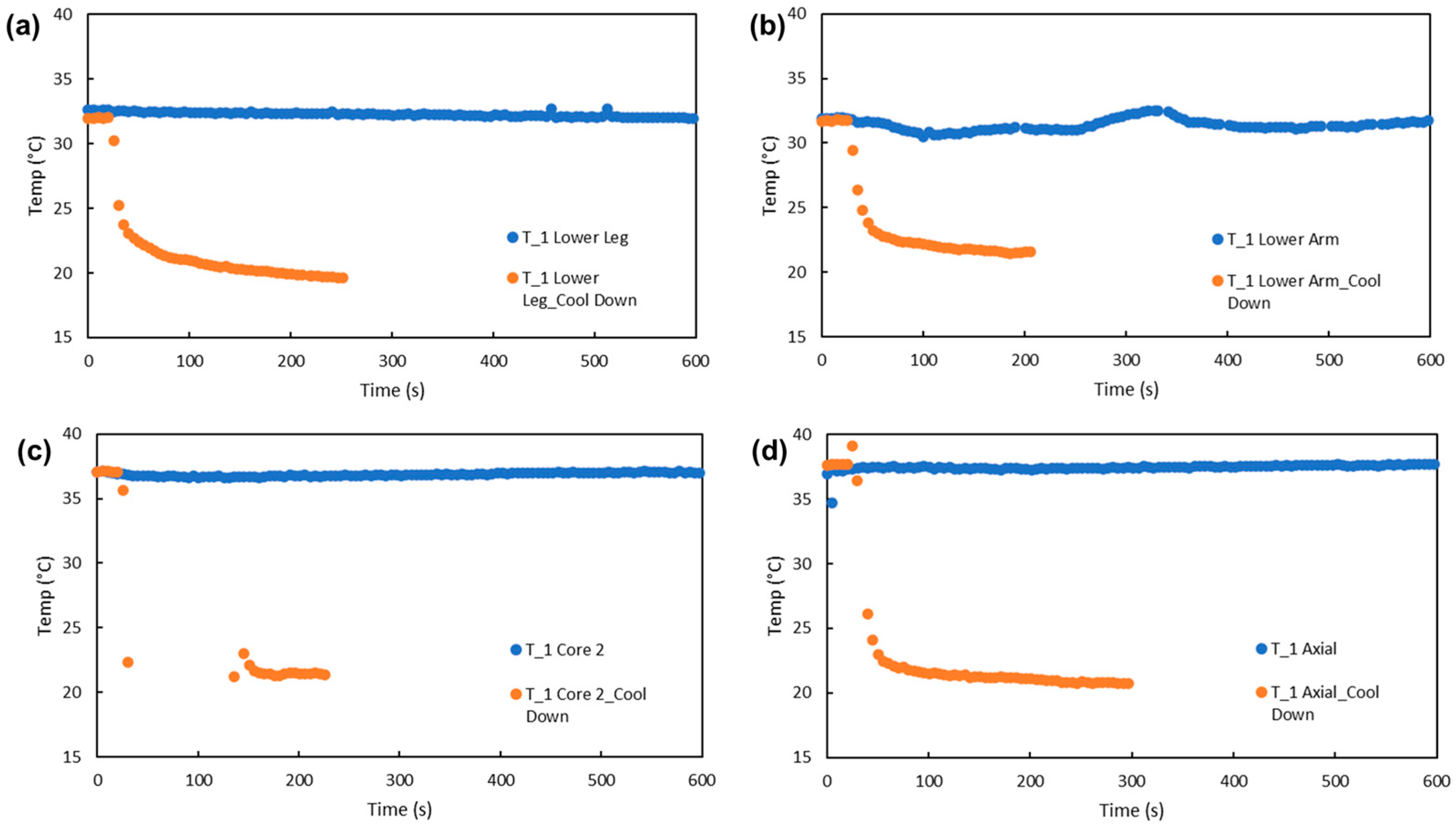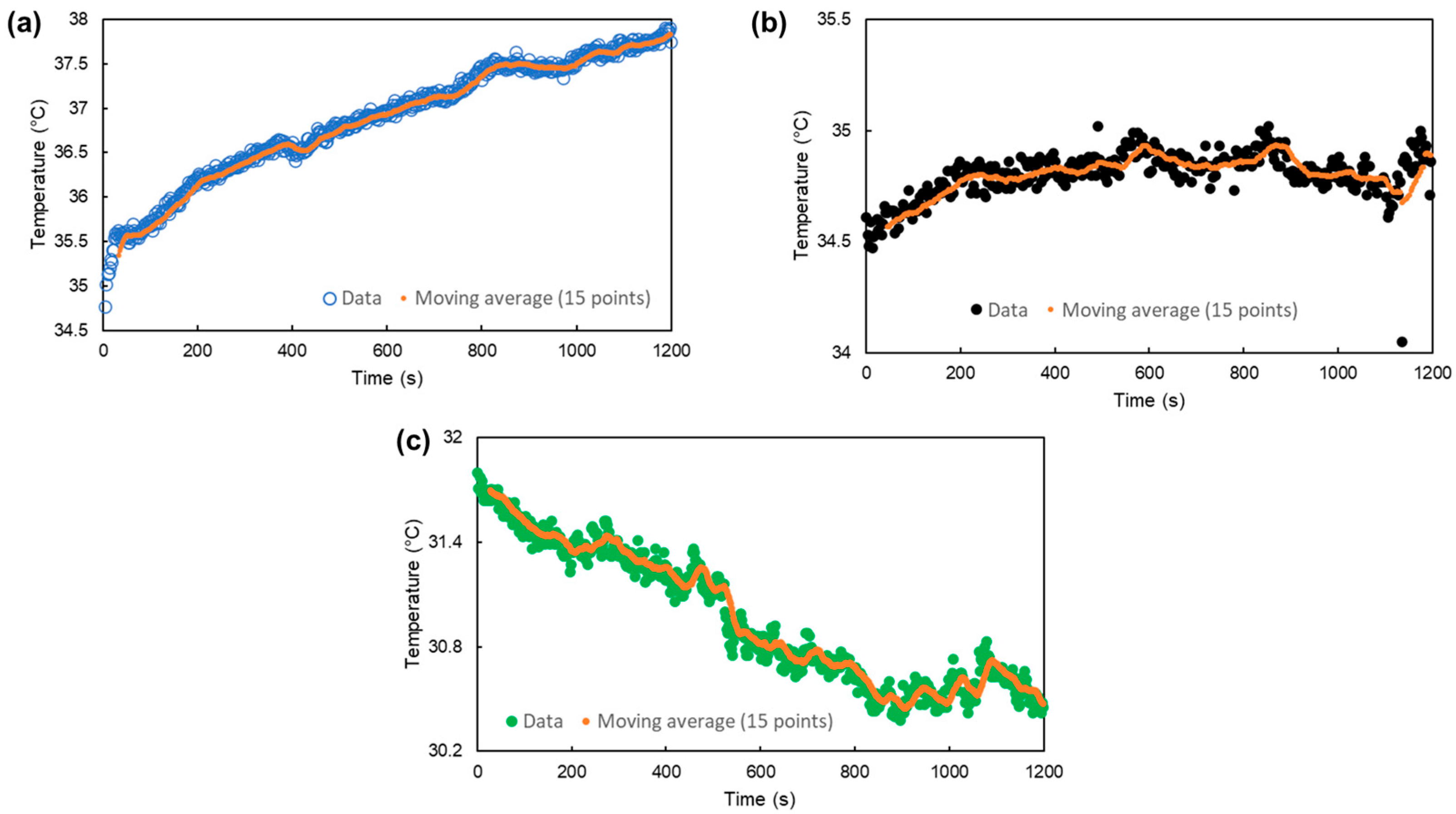Conformable, Wearable Embroidered Temperature Sensors for Real-Time Monitoring in Extreme Environments †
Abstract
1. Introduction
2. Methods
3. Results and Discussion
Author Contributions
Funding
Institutional Review Board Statement
Informed Consent Statement
Data Availability Statement
Acknowledgments
Conflicts of Interest
References
- Hayes, P. Diving and Hypothermia. Arc Medic. Res. 1991, 50, 37–42. [Google Scholar]
- Zhang, Z.; Liu, Z.; Lei, J.; Chen, L.; Li, L.; Zhao, N.; Fang, X.; Ruan, Y.; Tian, B.; Zhao, L. Flexible thin film thermocouples: From structure, material, fabrication to application. iScience 2023, 26, 107303. [Google Scholar] [CrossRef] [PubMed]
- Molki, A. Simple demonstrations of the Seebeck Effect. Sci. Ed. Rev. 2010, 9, 103–107. [Google Scholar]
- Moran, D.S.; Mendal, L. Core Temperature Measurement. Sports Med. 2002, 32, 879–885. [Google Scholar] [CrossRef] [PubMed]
- Geneva, I.I.; Cuzzo, B.; Fazili, T.; Javaid, W. Normal Body Temperature: A Systematic Review. Open Forum Infect. Dis. 2019, 6, ofz032. [Google Scholar] [CrossRef] [PubMed]
- Stoner, H.B.; Barker, P.; Riding, G.S.G.; Hazlehurst, D.E.; Taylor, L.; Marcuson, R.W. Relationships between skin temperature and perfusion in the arm and leg. Clin. Physiol. 1991, 11, 27–40. [Google Scholar] [CrossRef] [PubMed]
- Marui, S.; Misawa, A.; Tanaka, Y.; Nagashima, K. Assessment of axillary temperature for the evaluation of normal body temperature of healthy young adults at rest in a thermoneutral environment. J. Physiol. Anthropol. 2017, 36, 18. [Google Scholar] [CrossRef] [PubMed]
- Mekjavic, I.; Tipton, M.; Eiken, O. Thermal Considerations in Diving. In Bennett and Elliotts’ Physiology and Medicine of Diving; Brubakk, A., Neuman, T., Eds.; W.B. Saunders: St. Louis, MO, USA, 2002; Chapter 4. [Google Scholar]
- Gajsek, U.; Sieber, A.; Finderle, Z. Thermal balance of spinal cord injured divers during cold water diving: A case control study. Diving Hyperb. Med. 2020, 50, 256–263. [Google Scholar] [CrossRef] [PubMed]


Disclaimer/Publisher’s Note: The statements, opinions and data contained in all publications are solely those of the individual author(s) and contributor(s) and not of MDPI and/or the editor(s). MDPI and/or the editor(s) disclaim responsibility for any injury to people or property resulting from any ideas, methods, instructions or products referred to in the content. |
© 2024 by the authors. Licensee MDPI, Basel, Switzerland. This article is an open access article distributed under the terms and conditions of the Creative Commons Attribution (CC BY) license (https://creativecommons.org/licenses/by/4.0/).
Share and Cite
Amers, E.L.; Orme, B.V.; Torun, H.; Wood, D.; Shi, Y.; Nettleton-Parker, J.; Dodd, L.E. Conformable, Wearable Embroidered Temperature Sensors for Real-Time Monitoring in Extreme Environments. Eng. Proc. 2023, 52, 6. https://doi.org/10.3390/engproc2023052006
Amers EL, Orme BV, Torun H, Wood D, Shi Y, Nettleton-Parker J, Dodd LE. Conformable, Wearable Embroidered Temperature Sensors for Real-Time Monitoring in Extreme Environments. Engineering Proceedings. 2023; 52(1):6. https://doi.org/10.3390/engproc2023052006
Chicago/Turabian StyleAmers, Emmy L., Bethany V. Orme, Hamdi Torun, David Wood, Yuyuan Shi, Janet Nettleton-Parker, and Linzi E. Dodd. 2023. "Conformable, Wearable Embroidered Temperature Sensors for Real-Time Monitoring in Extreme Environments" Engineering Proceedings 52, no. 1: 6. https://doi.org/10.3390/engproc2023052006
APA StyleAmers, E. L., Orme, B. V., Torun, H., Wood, D., Shi, Y., Nettleton-Parker, J., & Dodd, L. E. (2023). Conformable, Wearable Embroidered Temperature Sensors for Real-Time Monitoring in Extreme Environments. Engineering Proceedings, 52(1), 6. https://doi.org/10.3390/engproc2023052006





